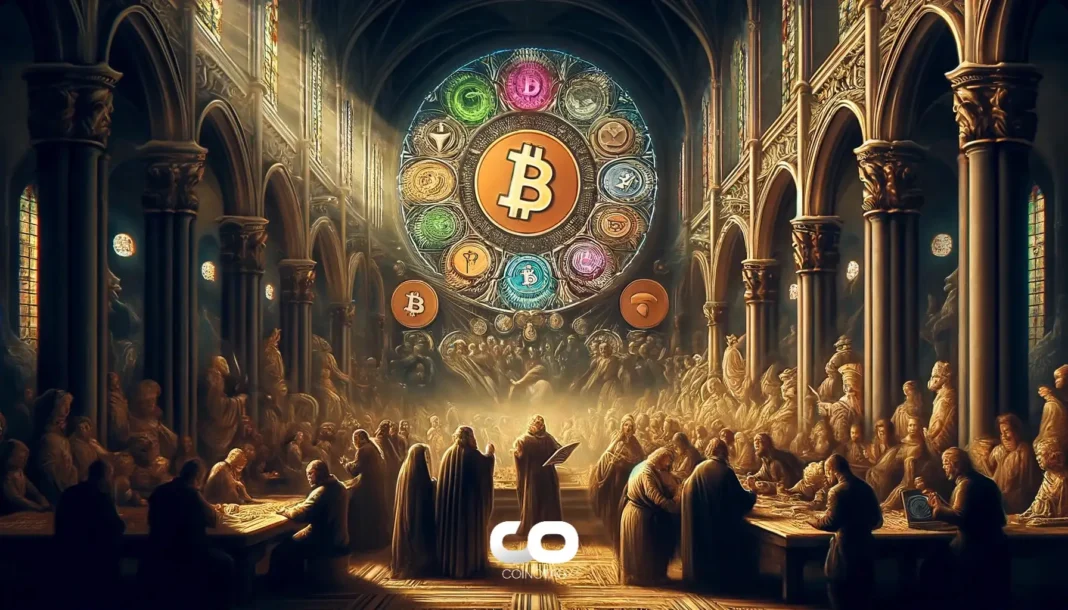CZ, Binance’s founder, critiques Peter Schiff’s tokenized gold plans, calling it a “trust me bro” token reliant on central custodians rather than true blockchain innovation, highlighting risks in custody and long-term trust.
-
CZ emphasizes that tokenized gold often involves off-chain storage, depending on third-party promises that may fail during crises.
-
Peter Schiff’s pivot from Bitcoin critic to gold token proponent draws skepticism amid gold’s recent price plunge below $4,100.
-
Gold has averaged 3.6% annual returns over 45 years, yet faces deep consolidations, contrasting Schiff’s $6,000 prediction by Christmas.
Discover CZ’s sharp take on Peter Schiff’s tokenized gold initiative and why it falls short on blockchain promises. Explore gold’s market struggles and Bitcoin’s resilience in this crypto news update—stay informed on key debates.
What is CZ’s Reaction to Peter Schiff’s Tokenized Gold Plans?
CZ’s reaction to Peter Schiff’s tokenized gold plans underscores a fundamental debate in the crypto space about trust and decentralization. Changpeng Zhao, known as CZ and the founder of Binance, publicly critiqued Schiff’s announcement of a blockchain-based gold tokenization product, arguing that it does not fully leverage blockchain’s potential. In a series of posts, CZ pointed out that such tokens typically represent claims on physical gold stored in vaults, managed by centralized custodians, rather than being truly on-chain assets.
How Does Tokenized Gold Differ from Bitcoin in CZ’s View?
Tokenized gold, as proposed by Peter Schiff, aims to enhance accessibility and transferability of physical gold through blockchain technology. However, CZ argues that it remains tethered to traditional trust models. Unlike Bitcoin, which operates on a decentralized ledger where users control their assets without intermediaries, tokenized gold relies on a custodian to hold the physical metal. This setup introduces vulnerabilities: if the custodian faces bankruptcy, hacking, or operational changes, token holders could lose access to their assets.
CZ highlighted this in his commentary, noting that the product essentially functions like a bank’s promise to redeem deposits. He questioned the reliability of these promises over time, especially in scenarios involving economic turmoil or geopolitical conflicts. According to market data referenced in COINOTAG reports, no major tokenized gold product has achieved widespread adoption, supporting CZ’s view that the concept prioritizes convenience over genuine innovation. Experts in the blockchain space, including those from decentralized finance protocols, echo this sentiment, stressing that true blockchain utility eliminates the need for “trust me bro” assurances from third parties.
Frequently Asked Questions
What prompted Peter Schiff to launch a tokenized gold product?
Peter Schiff, a long-time advocate for gold and critic of Bitcoin, announced his tokenized gold initiative to make physical gold more accessible via blockchain. This move comes after years of dismissing cryptocurrencies, aiming to bridge traditional assets with digital efficiency while maintaining gold’s role as a store of value amid market volatility.
Why is gold’s price dropping despite Schiff’s bullish predictions?
Gold prices fell below $4,100 on October 22, 2025, contradicting Peter Schiff’s forecast of reaching $6,000 by Christmas. Factors include strengthening economic indicators reducing safe-haven demand, alongside Bitcoin’s 1.17% surge to $109,629 in the last 24 hours, which is drawing investor interest away from traditional assets like gold.
Key Takeaways
- Tokenized Gold’s Limitations: CZ warns that these products depend on centralized custodians, mimicking traditional banking risks rather than embracing blockchain’s decentralized ethos.
- Schiff’s Market Challenges: Recent gold price declines to record lows highlight the volatility of precious metals, with historical data showing 3.6% average annual returns over 45 years marred by prolonged consolidations.
- Bitcoin’s Resilience: Amid gold’s downturn, Bitcoin shows recovery signs, up 1.17% to $109,629, reinforcing its appeal as a digital alternative in uncertain times—consider diversifying portfolios accordingly.
Conclusion
In the ongoing discourse surrounding CZ’s reaction to Peter Schiff’s tokenized gold plans, the crypto community is reminded of blockchain’s core promise: reducing reliance on intermediaries. While Schiff’s initiative seeks to modernize gold through tokenization, critics like CZ and traders such as Peter Brandt point to inherent trust issues and gold’s underwhelming performance, with prices dipping below $4,100 despite optimistic forecasts. As Bitcoin navigates its volatility toward potential highs, investors should weigh these debates carefully. Looking ahead, advancements in decentralized asset protocols could redefine how traditional stores of value integrate with crypto, offering more secure options for the future.
Changpeng Zhao’s (CZ) commentary on Peter Schiff’s latest venture into tokenized gold has ignited fresh discussions in the cryptocurrency world. Schiff, renowned for his staunch advocacy of gold and persistent skepticism toward Bitcoin, revealed plans for a blockchain-enabled gold token. This development marks a surprising shift, given his history of predicting Bitcoin’s downfall, including a recent forecast of an impending price collapse.
Schiff’s tokenized gold aims to streamline ownership and transactions of physical gold, making it easier to buy, sell, and transfer digitally. By leveraging blockchain, proponents argue it could attract a broader audience to gold as a hedge against inflation and economic instability. Yet, CZ’s response cuts through the hype, focusing on the practical realities of implementation.
In his critique, CZ clarified that he holds no grudge against gold as an asset. Instead, he targeted the overhyped narrative surrounding tokenized versions. He explained that these tokens do not place physical gold directly on the blockchain. Rather, they serve as digital IOUs backed by metal stored in secure vaults, overseen by a central entity. This model, CZ noted, mirrors the custodial systems in traditional finance, complete with the associated risks.
Consider the parallels to banking: just as depositors trust banks to safeguard their funds, tokenized gold holders must rely on the issuer to maintain the gold reserves and honor redemptions. But trust is fragile. CZ posed critical questions about the longevity of these arrangements. What happens if the custodian encounters financial distress, a cyberattack, or shifts in ownership? In times of war, hyperinflation, or global disruptions, will these promises hold firm after years or decades?
CZ’s pointed remark—”trust me bro” token—captures the essence of his skepticism. He attributes the lack of traction for existing tokenized gold products to these very concerns. Despite the allure of combining gold’s stability with blockchain’s speed, the absence of full decentralization undermines the innovation claim. This perspective aligns with broader blockchain philosophy, where the technology’s strength lies in verifiable, trustless systems.
The debate extends beyond theory into current market dynamics. Peter Schiff’s announcement coincides with challenging times for gold. On Wednesday, October 22, 2025, gold prices plummeted to record lows, slipping under $4,100 per ounce. This downturn has amplified criticism from the crypto community, with veteran trader Peter Brandt joining the chorus.
Brandt, known for his technical analysis, shared a historical chart of gold’s performance, illustrating its turbulent path for investors. Over the past 45 years, gold has delivered an average annual return of just 3.6%, punctuated by extended periods of stagnation and sharp declines. These consolidations have tested the patience of holders, contrasting sharply with the explosive growth seen in assets like Bitcoin.
Schiff’s recent optimism—predicting gold would soar to $6,000 by Christmas, surpassing both Bitcoin and the S&P 500—now appears overly ambitious. The precious metal’s slide has fueled jabs from crypto enthusiasts, who point to Bitcoin’s relative strength. In the last 24 hours leading up to October 22, 2025, Bitcoin edged up by 1.17% to $109,629, signaling potential recovery amid ongoing volatility.
This juxtaposition highlights a key tension: while Schiff pivots toward blockchain for gold, the market is favoring digital-native assets. CZ’s intervention serves as a reminder that not all blockchain applications deliver on decentralization’s promise. True innovation, he implies, should empower users with direct control, free from the pitfalls of centralized oversight.
From a broader viewpoint, Schiff’s foray into tokenization reflects evolving attitudes in finance. Traditional gold bugs are exploring crypto tools to enhance liquidity, but without addressing custody risks, these efforts may falter. Data from market analysts, as covered in reports like those from COINOTAG, underscores gold’s historical underperformance relative to its reputation as a safe haven.
Meanwhile, Bitcoin continues to demonstrate resilience. Despite Schiff’s dire predictions, it has weathered crashes and consolidations, buoyed by institutional adoption and technological upgrades. CZ, drawing from his experience building Binance into the world’s largest crypto exchange, brings credibility to his analysis. His insights, grounded in real-world blockchain deployment, emphasize practical utility over speculative marketing.
As the crypto landscape matures, debates like this one between CZ and Schiff will shape investor perceptions. Gold tokenization could find a niche, but only if it evolves toward greater transparency and user sovereignty. For now, CZ’s critique stands as a cautionary note: blockchain’s power is in eliminating trust dependencies, not repackaging them.






